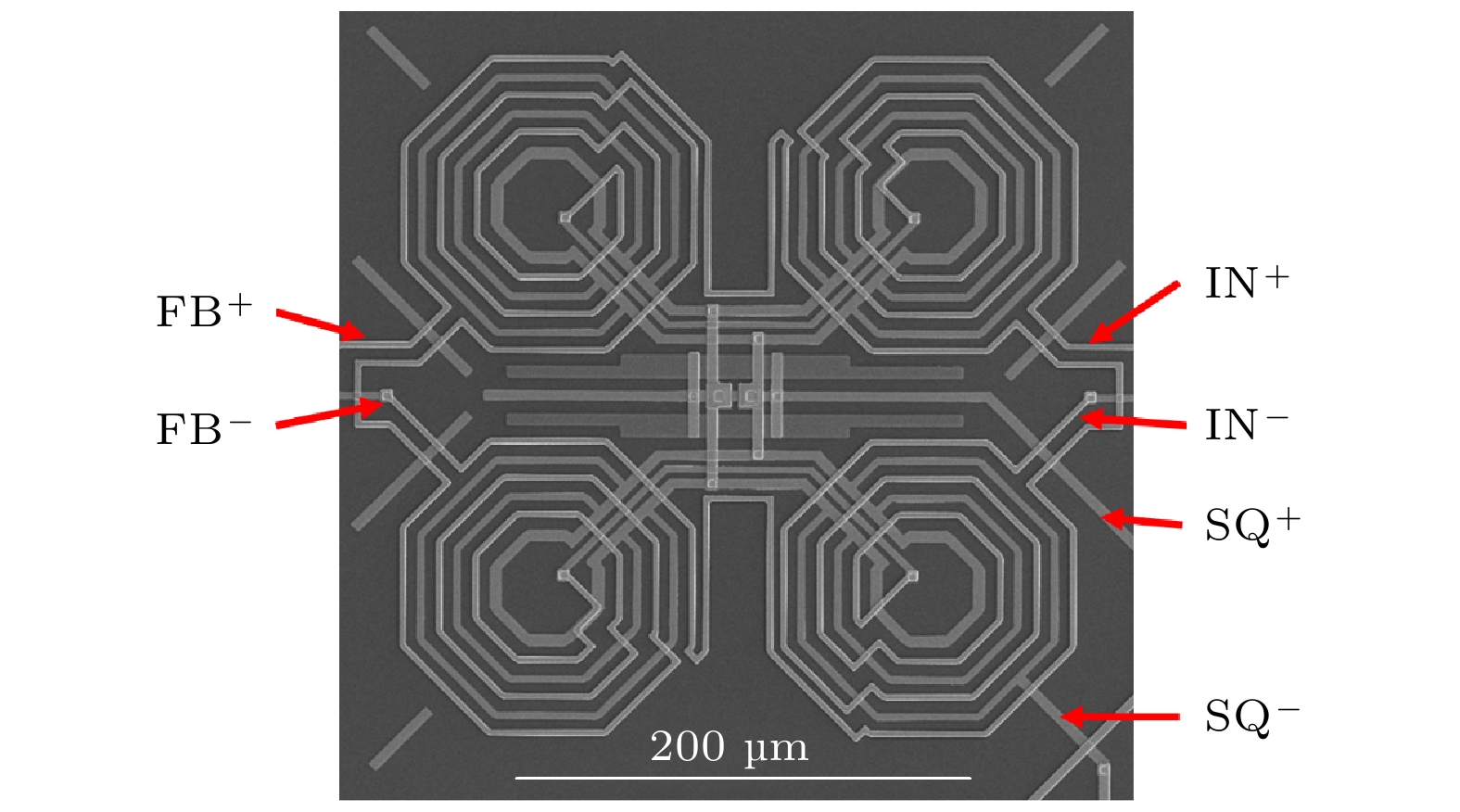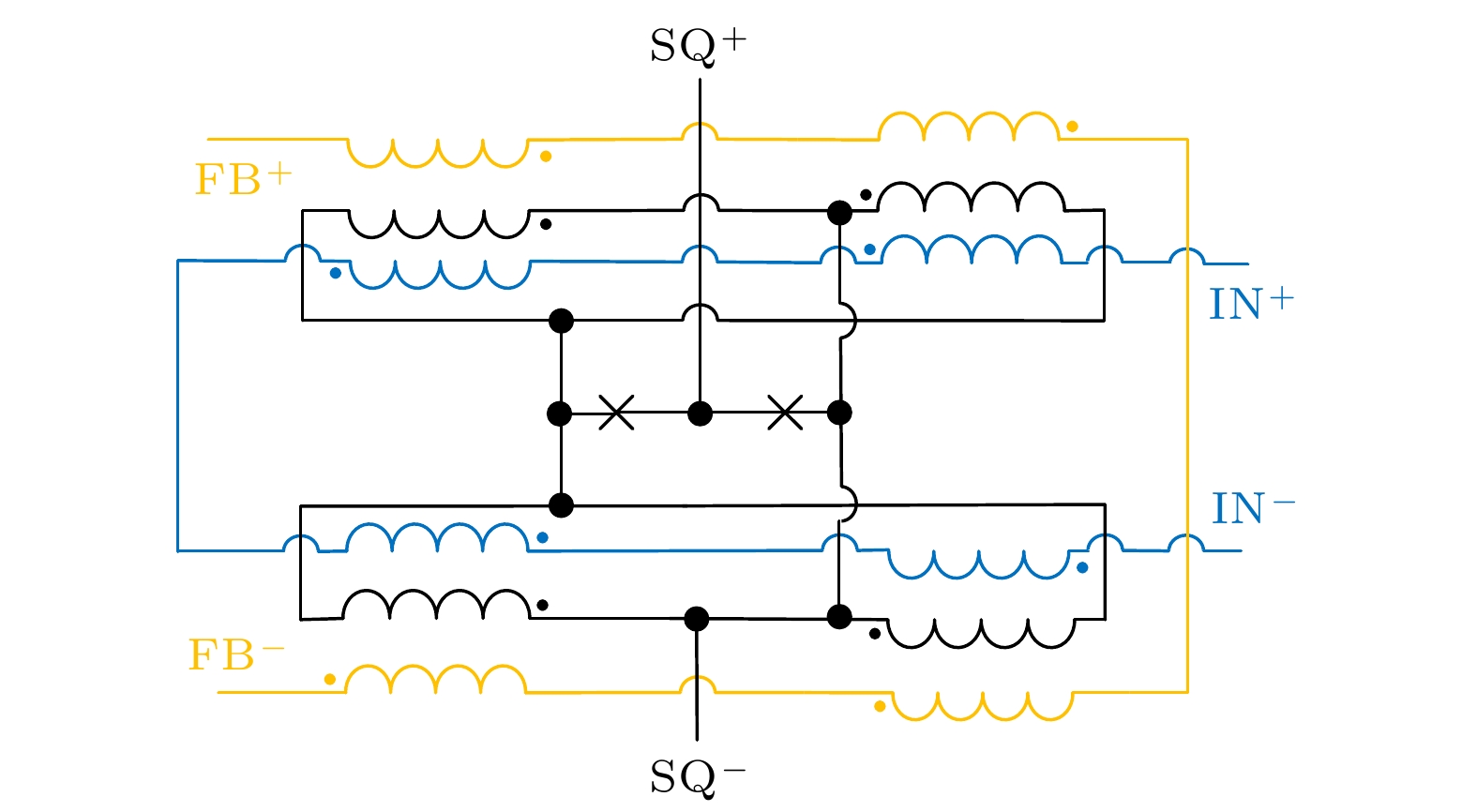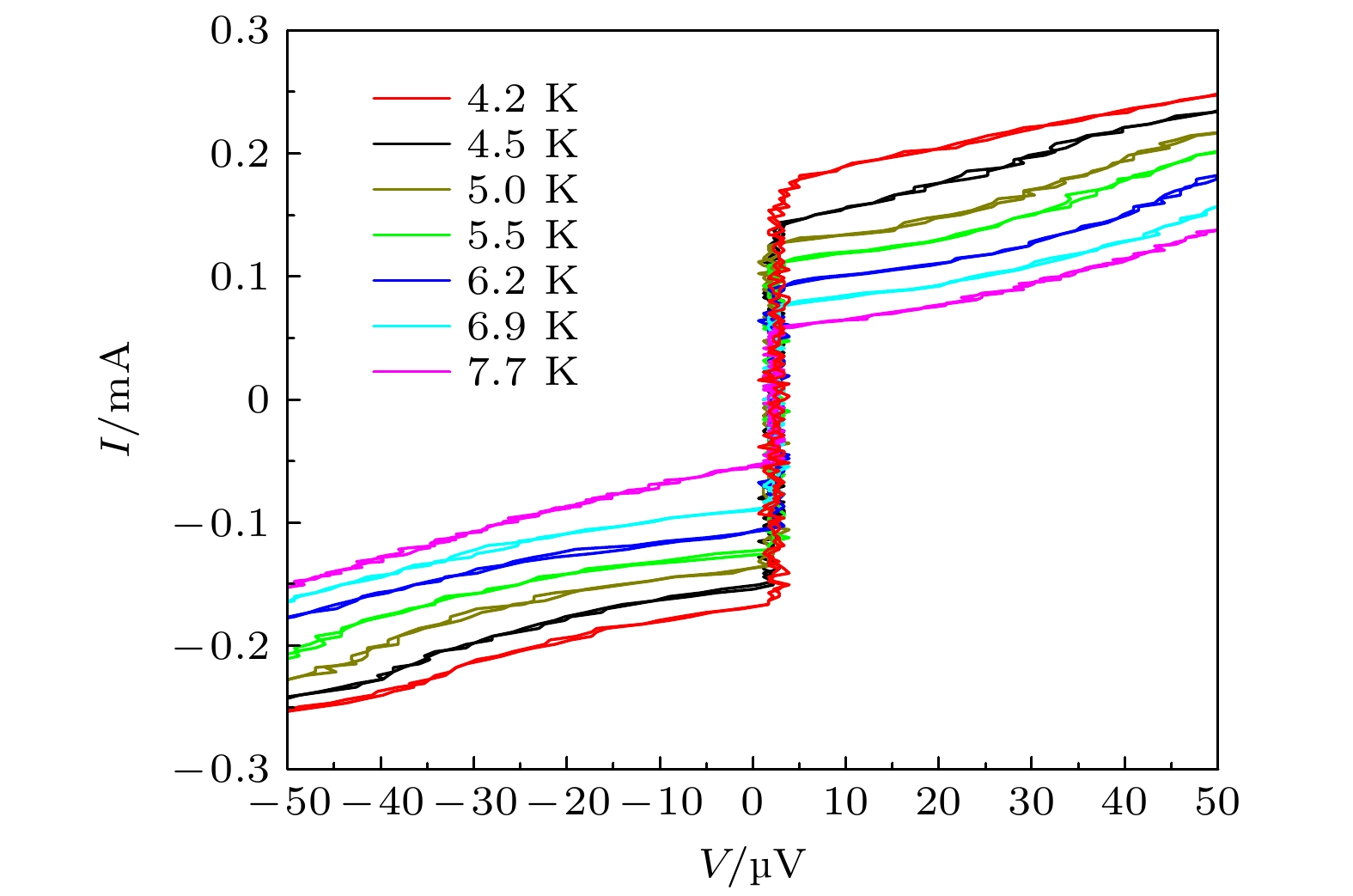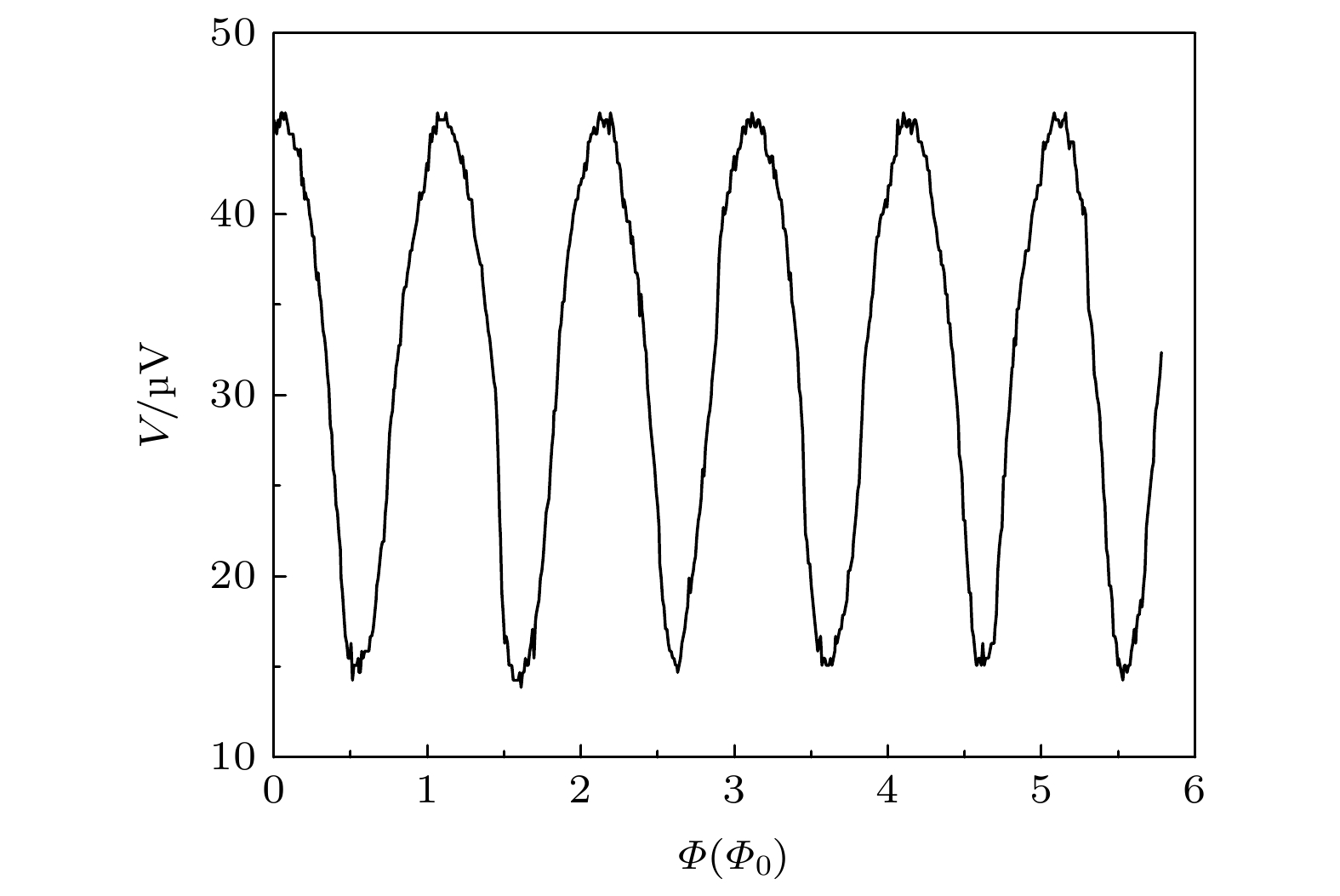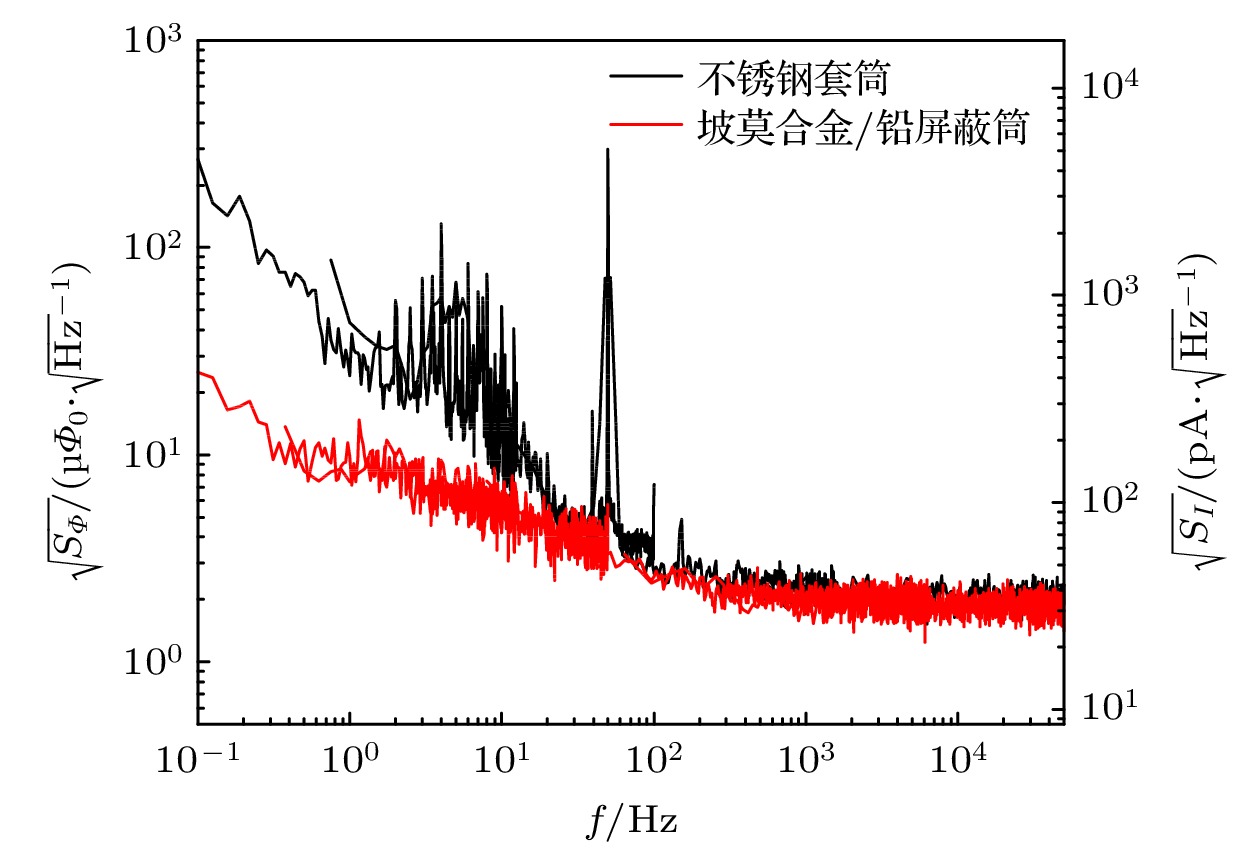-
超导量子干涉仪(superconducting quantum interference device, SQUID)具有极低的噪声水平, 极高的磁场灵敏度和电流灵敏度, 可探测低噪声传感器的微弱电流信号. SQUID电流传感器已成为超导转变边缘探测器(transition-edge sensor, TES)等低噪声探测信号读出的唯一选择. 本文研制了一种针对TES信号读出应用的二阶梯度交叉耦合SQUID电流传感器. 根据TES的信号读出需求, 设计了SQUID电流传感器的结构和各项参数. 其中, SQUID环路、输入线圈和反馈线圈均采用二阶梯度结构. SQUID环路与输入线圈、反馈线圈均采用不同平面交叉耦合方式, 可有效地减弱寄生电容. 通过优化工艺, 成功地研制出基于Nb/Al-AlOx/Nb约瑟夫森结的二阶梯度交叉耦合SQUID电流传感器. 液氦温区测试结果显示, 输入线圈电流灵敏度为17 μA/Φ0, 磁通白噪声为2 μΦ0/
$ \sqrt{{\rm{H}}{\rm{z}}} $ , 电流白噪声为34 pA/$ \sqrt{{\rm{H}}{\rm{z}}} $ . 在无磁屏蔽条件下的噪声测试结果显示, 二阶梯度交叉耦合SQUID电流传感器具有良好的抵抗环境电磁干扰能力.Superconducting quantum interference device (SQUID) has extremely high magnetic field sensitivity, current sensitivity, and can detect a low-noise weak current signal. The SQUID current sensor has become the only option of the readout of low-noise detector, such as transition-edge sensor (TES). In this paper, a second-order gradiometric cross-coupled SQUID current sensor for TES application is developed. According to the requirements for TES detectors, the structure and various parameters of SQUID current sensor are designed. The SQUID loop, input coil and feedback coil of the SQUID current sensor all use the second-order gradiometric structure. All the couple ways between SQUID loop and input coil or feedback coil adopt cross-coupling mode in different planes, which can effectively weaken the parasitic capacitance. A second-order gradiometric cross-coupled SQUID current sensor based on Nb/Al-AlOx/Nb Josephson junction is successfully fabricated on a silicon wafer by optimizing the process. The properties of the second-order gradiometric cross-coupled SQUID current sensor are measured at liquid helium temperature. The bias current of SQUID is 215 μA when the modulation depth of V-Φ modulation curve is maximum. The maximum modulation peak of SQUID is 31 μV. The flux-to-voltage transfer coefficient of SQUID is 108 μV/Φ0. The input coil current sensitivity is 17 μA/Φ0, the mutual inductance between SQUID loop and input coil is 117 pH. The current sensitivity of feedback coil is 86 μA/Φ0, the mutual inductance between SQUID loop and feedback coil is 23 pH. The second-order gradiometric cross-coupled SQUID current sensor has a white flux noise of 2 μΦ0/$ \sqrt{{\rm{H}}{\rm{z}}} $ and a white current noise of 34 pA/$ \sqrt{{\rm{H}}{\rm{z}}} $ with 1/f corner frequency around 200 Hz. The result of noise level under the condition without magnetic shielding shows that the SQUID current sensor with second-order gradiometric cross-coupled structure has an excellent capability of weakening the environmental electromagnetic interference. In the future, we will further improve the mutual inductance of the second-order gradiometric cross-coupled SQUID current sensor between SQUID loop and input coil, optimize the size and critical current of Josephson junction, in order to improve the input sensitivity of SQUID device, reduce the current noise level and the 1/f corner frequency, and meet more requirements for TES applications.-
Keywords:
- superconducting quantum interference device /
- transition-edge sensor /
- flux noise /
- current noise /
- current sensitivity
[1] Clarke J, Braginski A I 2004 The SQUID Handbook (Vol. 1) (KgaA, Weinheim: Wiley-VCH Verlag GmbH & Co.) pp1−210
[2] Granata C, Vettoliere A, Russo R, Fretto M, de Leo N, Lacquaniti V 2013 Appl. Phys. Lett. 103 102602
 Google Scholar
Google Scholar
[3] Ullom J N, Bennett D A 2015 Supercond. Sci. Technol. 28 084003
 Google Scholar
Google Scholar
[4] Jackson B D, Korte P A J, Kuur J, Mauskopf P D, Beyer J, Bruijn M P, Cros A, Gao J R, Griffin D, Hartog R, Kiviranta M, Lange G, Leeuwen B J, Macculi C, Ravera L, Trappe N, Weers H, Withington S 2012 IEEE Trans. Terahertz Sci. and Technol. 2 12
 Google Scholar
Google Scholar
[5] Henderson S W, Ahmed Z, Austermann J, Becker D, Bennett D A, Brown D, Chaudhuri S, Cho H M S, D'Ewart J M, Dober B, Duff S M, Dusatko J E, Fatigoni S, Frisch J C, Gard J D, Halpern M, Hilton G C, Hubmayr J, Irwin K D, Karpel E D, Kernasovskiy S S, Kuenstner S E, Kuo C L, Li D, Mates J A B, Reintsema C D, Smith S R, Ullom J, Vale L R, Winkle D D V, Vissers M, Yu C 2018 Proc. SPIE, Millimeter, Submillimeter, and Far-Infrared Detectors and Instrumentation for Astronomy IX Texas, United States, June 10−15 2018 p1070819
[6] Cui W, Chen L B, Gao B, Guo F L, Jin H, Wang G L, Wang J J, Wang W, Wang Z S, Wang Z, Yuan F, Zhang W 2020 J. Low Temp. Phys. 199 502
 Google Scholar
Google Scholar
[7] Schmidt M, Helversen M, López M, Gericke F, Schlottmann E, Heindel T, Kück S, Reitzenstein S, Beyer J 2018 J. Low Temp. Phys. 193 1243
 Google Scholar
Google Scholar
[8] Irwin K D 2002 Physica C 368 203
 Google Scholar
Google Scholar
[9] Kempf S, Wegner M, Fleischmann A, Gastaldo L, Herrmann F, Papst M, Richter D, Enss C 2017 AIP Adv. 7 015007
 Google Scholar
Google Scholar
[10] Bennett D A, Mates J A B, Gard J D, Hoover A S, Rabin M W, Reintsema C D, Schmidt D R, Vale L R, Ullom J N 2015 IEEE Trans. Appl. Supercond. 25 2101405
 Google Scholar
Google Scholar
[11] Drung D, Abmann C, Beyer J, Kirste A, Peters M, Ruede F, Schurig T 2007 IEEE Trans. Appl. Supercond. 17 699
 Google Scholar
Google Scholar
[12] Stiehl G M, Cho H M, Hilton G C, Irwin K D, Mates J A B, Reintsema C D, Zink B L 2011 IEEE Trans. Appl. Supercond. 21 298
 Google Scholar
Google Scholar
[13] Beyer J, Drung D 2008 Supercond. Sci. Technol. 21 095012
 Google Scholar
Google Scholar
[14] Schurig T 2014 J. Phys. Conf. Ser. 568 032015
 Google Scholar
Google Scholar
[15] Silva-Feaver M, Arnold K, Barron D, Denison E V, Dobbs M, Groh J, Hilton G, Hubmayr J, Irwin K, Lee A, Vale L R 2018 J. Low Temp. Phys. 193 600
 Google Scholar
Google Scholar
[16] Schurig T, Trahms L 2009 IEEE CSC & ESAS European Superconductivity News Forum 3 RN9
 Google Scholar
Google Scholar
[17] 韩昊轩, 张国峰, 张雪, 梁恬恬, 应利良, 王永良, 彭炜, 王镇 2019 物理学报 68 138501
 Google Scholar
Google Scholar
Han H X, Zhang G F, Zhang X, Liang T T, Ying L L, Wang Y L, Peng W, Wang Z 2019 Acta Phys. Sin. 68 138501
 Google Scholar
Google Scholar
[18] Drung D 2016 IEEE CSC & ESAS European Supercon- ductivity News Forum 10 CR70
[19] SQUID sensors, Magnicon GmbH www.magnicon.com [2021-02-07]
[20] LTS Sensors, STAR Cryoelectronics www.starcryo.com [2021-02-07]
[21] Cantor R, Hall J A, Matlachov A N, Volegov P L 2007 IEEE Trans. Appl. Supercond. 17 672
 Google Scholar
Google Scholar
[22] Kempf S, Ferring A, Fleischmann A, Gastaldo L, Enss C, 2013 Supercond. Sci. Technol. 26 065012
 Google Scholar
Google Scholar
[23] Kempf S, Ferring A, Fleischmann A, Enss C 2015 Supercond. Sci. Technol. 28 045008
 Google Scholar
Google Scholar
[24] Doriese W B, Morgan K M, Bennett D A, Denison E V, Fitzgerald C P, Fowler J W, Gard J D, Hays-Wehle J P, Hilton G C, Irwin K D, Joe Y I, Mates J A B, O’Neil G C, Reintsema C D, Robbins N O, Schmidt D R, Swetz D S, Tatsuno H, Vale L R, Ullom J N 2016 J. Low Temp Phys 184 389
 Google Scholar
Google Scholar
[25] Zhang X, Zhang G, Wang Y, Rong L, Zhang S, Wu J, Qiu L, Xie X, Wang Z 2019 IEEE Trans. Appl. Supercond. 29 1600503
 Google Scholar
Google Scholar
[26] Kuriki S, Isobe Y, Mizutani Y 1987 J. Appl. Phys. 61 781
 Google Scholar
Google Scholar
[27] Carelli P, Chiaventi L, Leoni R, Pullano M, Spagnolo G S 1991 Clin. Phys. Physiol. Meas. 12 13
 Google Scholar
Google Scholar
[28] Beyer J, Drung D, Peters M, Schurig T, Bandler S R 2009 IEEE Trans. Appl. Supercond. 19 505
 Google Scholar
Google Scholar
[29] Xu D, Li J, Cao W, Liu J, Chen W 2020 Conference on Precision Electromagnetic Measurements Denver, United States, August 24−28 2020 p9191689
[30] Fourie C J, Perold W J 2005 IEEE Trans. Appl. Supercond. 15 300
 Google Scholar
Google Scholar
[31] Drung D, Hinnrichs C, Barthelmess H 2006 Supercond. Sci. Technol. 19 S235
 Google Scholar
Google Scholar
[32] Drung D, Ludwig F, Müller W, Steinhoff U, Trahms L, Koch H, Shen Y Q, Jensen M B, Vase P, Holst T, Freltoft T, Curio G 1996 Appl. Phys. Lett. 68 1421
 Google Scholar
Google Scholar
-
表 1 二阶梯度交叉耦合SQUID电流传感器的设计参数
Table 1. Design parameters of the second-order gradiometric cross-coupled SQUID current sensor.
参数 设计值 约瑟夫森结尺寸S/(µm × µm) 7 × 7 约瑟夫森结临界电流I0/µA 49 约瑟夫森结电容CJ/pF 2 并联电阻Rsh/Ω 0.84 回滞系数βc 0.2 调制系数βL 1.6 SQUID环路电感LSQ/pH 33 SQUID环路与输入线圈互感MIN/pH 130 SQUID环路与反馈线圈互感MFB/pH 36 输入线圈电感LIN/nH 3 反馈线圈电感LFB/nH 1 输入电流灵敏度1/MIN/(μA·Φ0–1) 15 反馈电流灵敏度1/MFB/(μA·Φ0–1) 56 表 2 二阶梯度交叉耦合SQUID电流传感器的性能参数
Table 2. Property parameters of the second-order gradiometric cross-coupled SQUID current sensor.
参数 实测值 偏置电流Ib, max/μA 215 并联电阻Rsh/Ω 1 回滞系数βc 0.67 输入电流灵敏度1/MIN/(μA·Φ0–1) 17 反馈电流灵敏度1/MFB/(μA·Φ0–1) 86 磁通-电压转换系数VΦ/(μV·Φ0–1) 108 最大调制峰值Vpp/μV 31 磁通白噪声$\sqrt{S_{\varPhi}} $/(μΦ0·$ \sqrt{{\rm{H}}{\rm{z}}} $–1) 2 电流白噪声$\sqrt{S_I} $/(pA·$ \sqrt{{\rm{H}}{\rm{z}}} $–1) 34 SQUID环路与输入线圈互感MIN/pH 117 SQUID环路与反馈线圈互感MFB/pH 24 -
[1] Clarke J, Braginski A I 2004 The SQUID Handbook (Vol. 1) (KgaA, Weinheim: Wiley-VCH Verlag GmbH & Co.) pp1−210
[2] Granata C, Vettoliere A, Russo R, Fretto M, de Leo N, Lacquaniti V 2013 Appl. Phys. Lett. 103 102602
 Google Scholar
Google Scholar
[3] Ullom J N, Bennett D A 2015 Supercond. Sci. Technol. 28 084003
 Google Scholar
Google Scholar
[4] Jackson B D, Korte P A J, Kuur J, Mauskopf P D, Beyer J, Bruijn M P, Cros A, Gao J R, Griffin D, Hartog R, Kiviranta M, Lange G, Leeuwen B J, Macculi C, Ravera L, Trappe N, Weers H, Withington S 2012 IEEE Trans. Terahertz Sci. and Technol. 2 12
 Google Scholar
Google Scholar
[5] Henderson S W, Ahmed Z, Austermann J, Becker D, Bennett D A, Brown D, Chaudhuri S, Cho H M S, D'Ewart J M, Dober B, Duff S M, Dusatko J E, Fatigoni S, Frisch J C, Gard J D, Halpern M, Hilton G C, Hubmayr J, Irwin K D, Karpel E D, Kernasovskiy S S, Kuenstner S E, Kuo C L, Li D, Mates J A B, Reintsema C D, Smith S R, Ullom J, Vale L R, Winkle D D V, Vissers M, Yu C 2018 Proc. SPIE, Millimeter, Submillimeter, and Far-Infrared Detectors and Instrumentation for Astronomy IX Texas, United States, June 10−15 2018 p1070819
[6] Cui W, Chen L B, Gao B, Guo F L, Jin H, Wang G L, Wang J J, Wang W, Wang Z S, Wang Z, Yuan F, Zhang W 2020 J. Low Temp. Phys. 199 502
 Google Scholar
Google Scholar
[7] Schmidt M, Helversen M, López M, Gericke F, Schlottmann E, Heindel T, Kück S, Reitzenstein S, Beyer J 2018 J. Low Temp. Phys. 193 1243
 Google Scholar
Google Scholar
[8] Irwin K D 2002 Physica C 368 203
 Google Scholar
Google Scholar
[9] Kempf S, Wegner M, Fleischmann A, Gastaldo L, Herrmann F, Papst M, Richter D, Enss C 2017 AIP Adv. 7 015007
 Google Scholar
Google Scholar
[10] Bennett D A, Mates J A B, Gard J D, Hoover A S, Rabin M W, Reintsema C D, Schmidt D R, Vale L R, Ullom J N 2015 IEEE Trans. Appl. Supercond. 25 2101405
 Google Scholar
Google Scholar
[11] Drung D, Abmann C, Beyer J, Kirste A, Peters M, Ruede F, Schurig T 2007 IEEE Trans. Appl. Supercond. 17 699
 Google Scholar
Google Scholar
[12] Stiehl G M, Cho H M, Hilton G C, Irwin K D, Mates J A B, Reintsema C D, Zink B L 2011 IEEE Trans. Appl. Supercond. 21 298
 Google Scholar
Google Scholar
[13] Beyer J, Drung D 2008 Supercond. Sci. Technol. 21 095012
 Google Scholar
Google Scholar
[14] Schurig T 2014 J. Phys. Conf. Ser. 568 032015
 Google Scholar
Google Scholar
[15] Silva-Feaver M, Arnold K, Barron D, Denison E V, Dobbs M, Groh J, Hilton G, Hubmayr J, Irwin K, Lee A, Vale L R 2018 J. Low Temp. Phys. 193 600
 Google Scholar
Google Scholar
[16] Schurig T, Trahms L 2009 IEEE CSC & ESAS European Superconductivity News Forum 3 RN9
 Google Scholar
Google Scholar
[17] 韩昊轩, 张国峰, 张雪, 梁恬恬, 应利良, 王永良, 彭炜, 王镇 2019 物理学报 68 138501
 Google Scholar
Google Scholar
Han H X, Zhang G F, Zhang X, Liang T T, Ying L L, Wang Y L, Peng W, Wang Z 2019 Acta Phys. Sin. 68 138501
 Google Scholar
Google Scholar
[18] Drung D 2016 IEEE CSC & ESAS European Supercon- ductivity News Forum 10 CR70
[19] SQUID sensors, Magnicon GmbH www.magnicon.com [2021-02-07]
[20] LTS Sensors, STAR Cryoelectronics www.starcryo.com [2021-02-07]
[21] Cantor R, Hall J A, Matlachov A N, Volegov P L 2007 IEEE Trans. Appl. Supercond. 17 672
 Google Scholar
Google Scholar
[22] Kempf S, Ferring A, Fleischmann A, Gastaldo L, Enss C, 2013 Supercond. Sci. Technol. 26 065012
 Google Scholar
Google Scholar
[23] Kempf S, Ferring A, Fleischmann A, Enss C 2015 Supercond. Sci. Technol. 28 045008
 Google Scholar
Google Scholar
[24] Doriese W B, Morgan K M, Bennett D A, Denison E V, Fitzgerald C P, Fowler J W, Gard J D, Hays-Wehle J P, Hilton G C, Irwin K D, Joe Y I, Mates J A B, O’Neil G C, Reintsema C D, Robbins N O, Schmidt D R, Swetz D S, Tatsuno H, Vale L R, Ullom J N 2016 J. Low Temp Phys 184 389
 Google Scholar
Google Scholar
[25] Zhang X, Zhang G, Wang Y, Rong L, Zhang S, Wu J, Qiu L, Xie X, Wang Z 2019 IEEE Trans. Appl. Supercond. 29 1600503
 Google Scholar
Google Scholar
[26] Kuriki S, Isobe Y, Mizutani Y 1987 J. Appl. Phys. 61 781
 Google Scholar
Google Scholar
[27] Carelli P, Chiaventi L, Leoni R, Pullano M, Spagnolo G S 1991 Clin. Phys. Physiol. Meas. 12 13
 Google Scholar
Google Scholar
[28] Beyer J, Drung D, Peters M, Schurig T, Bandler S R 2009 IEEE Trans. Appl. Supercond. 19 505
 Google Scholar
Google Scholar
[29] Xu D, Li J, Cao W, Liu J, Chen W 2020 Conference on Precision Electromagnetic Measurements Denver, United States, August 24−28 2020 p9191689
[30] Fourie C J, Perold W J 2005 IEEE Trans. Appl. Supercond. 15 300
 Google Scholar
Google Scholar
[31] Drung D, Hinnrichs C, Barthelmess H 2006 Supercond. Sci. Technol. 19 S235
 Google Scholar
Google Scholar
[32] Drung D, Ludwig F, Müller W, Steinhoff U, Trahms L, Koch H, Shen Y Q, Jensen M B, Vase P, Holst T, Freltoft T, Curio G 1996 Appl. Phys. Lett. 68 1421
 Google Scholar
Google Scholar
计量
- 文章访问数: 8331
- PDF下载量: 125
- 被引次数: 0















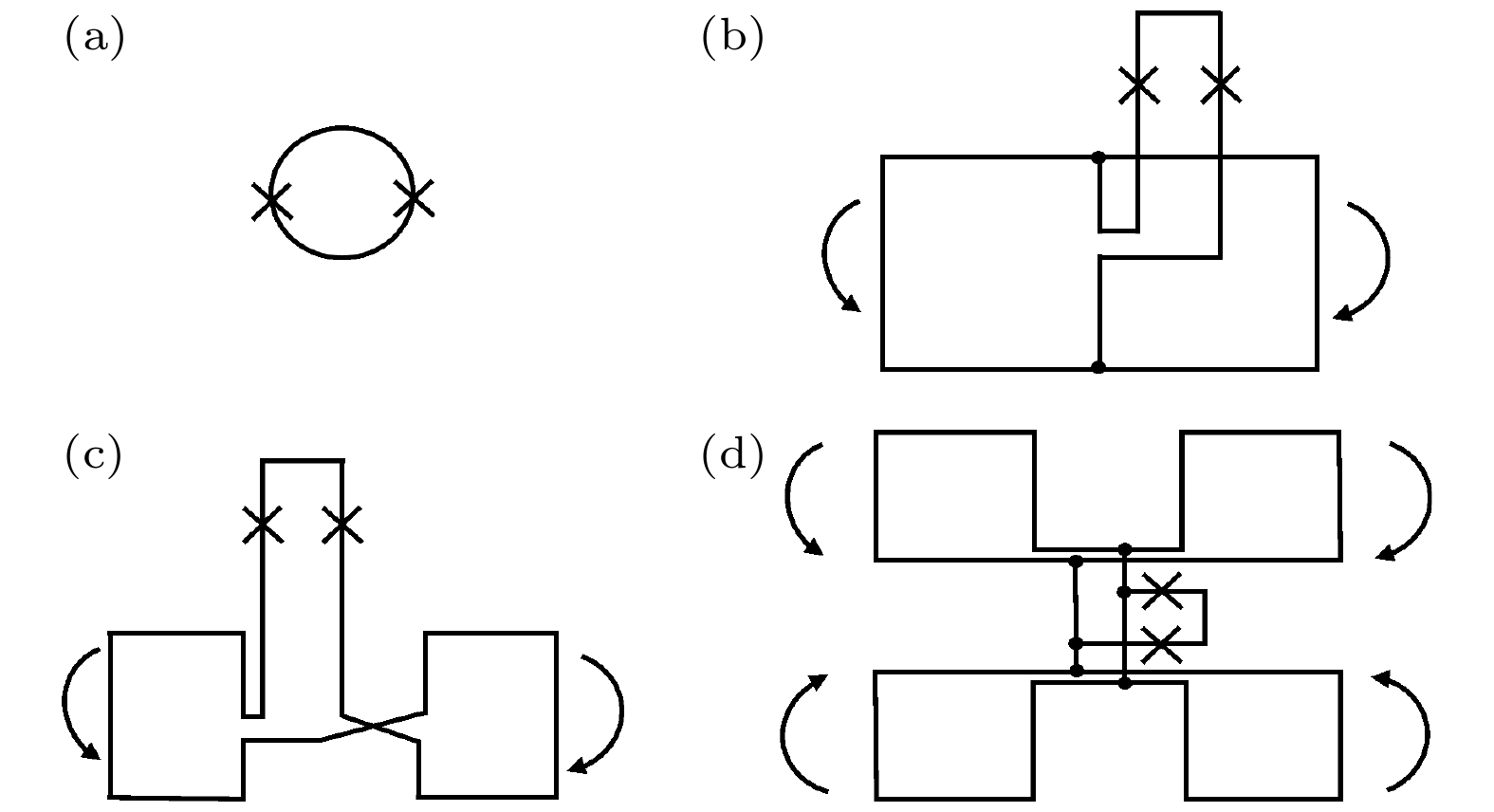
 下载:
下载:
